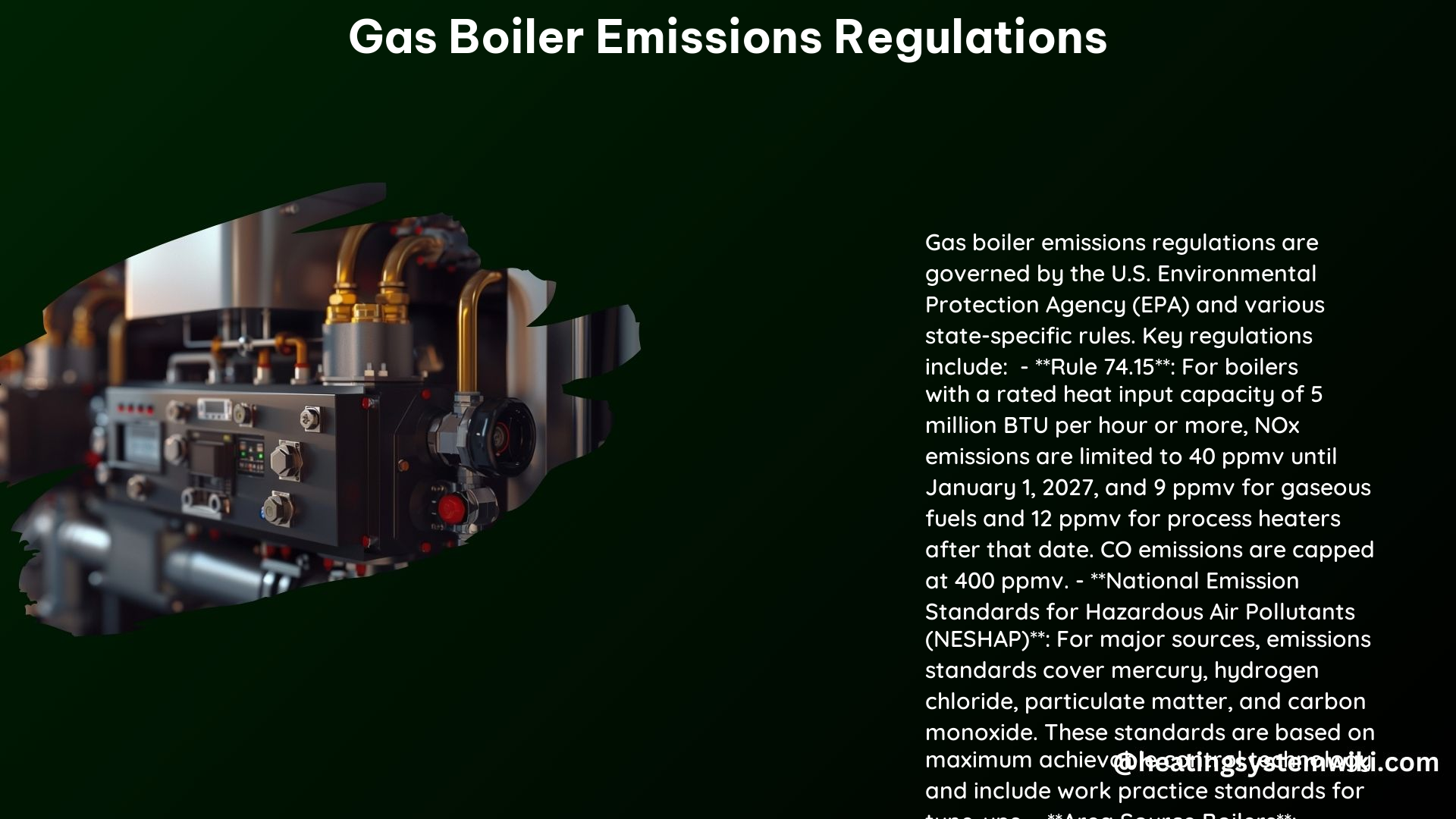Gas boiler emissions regulations are a set of comprehensive standards and guidelines established by government agencies to minimize the environmental impact of gas boilers. These regulations primarily focus on reducing the emissions of hazardous air pollutants (HAPs) and other pollutants from industrial, commercial, and institutional boilers. This in-depth guide will provide you with a detailed understanding of the key aspects of gas boiler emissions regulations, including emission standards, monitoring requirements, technical specifications, and compliance measures.
Emission Standards for Gas Boilers in New York City
The New York City Department of Environmental Protection (DEP) is responsible for regulating boiler emissions within the city. The DEP has set stringent standards for the following pollutants emitted from gas boilers:
- Nitrogen Oxides (NOx): Boilers with a heat input capacity of 10 million BTU per hour or more must meet a NOx emission limit of 9 parts per million by volume (ppmv) at 3% oxygen.
- Particulate Matter (PM): Boilers with a heat input capacity of 10 million BTU per hour or more must meet a PM emission limit of 0.010 grains per dry standard cubic foot (gr/dscf) at 3% oxygen.
- Carbon Monoxide (CO): Boilers with a heat input capacity of 10 million BTU per hour or more must meet a CO emission limit of 50 ppmv at 3% oxygen.
These emission limits are designed to significantly reduce the environmental impact of gas boilers in the New York City metropolitan area.
Emission Standards for Gas Boilers in New Jersey

The New Jersey Department of Environmental Protection (NJDEP) is responsible for regulating boiler emissions in the state. The NJDEP has set the following emission standards for gas boilers:
- Nitrogen Oxides (NOx): Boilers with a heat input capacity of 10 million BTU per hour or more must meet a NOx emission limit of 9 ppmv at 3% oxygen.
- Particulate Matter (PM): Boilers with a heat input capacity of 10 million BTU per hour or more must meet a PM emission limit of 0.015 gr/dscf at 3% oxygen.
- Carbon Monoxide (CO): Boilers with a heat input capacity of 10 million BTU per hour or more must meet a CO emission limit of 50 ppmv at 3% oxygen.
These emission standards are consistent with the regulations in New York City, ensuring a regional approach to reducing air pollution from gas boilers.
Monitoring Requirements for Gas Boiler Emissions under the Boiler MACT
The Boiler Maximum Achievable Control Technology (MACT) is a federal regulation that sets emission standards for hazardous air pollutants from industrial, commercial, and institutional boilers. The Boiler MACT requires regular monitoring and testing to ensure compliance with the emission standards. Specifically, the regulation mandates the following:
- Tune-ups: Boilers must undergo a tune-up every 12 months to optimize combustion efficiency and minimize emissions.
- Emissions Testing: Boilers must conduct emissions testing every 36 months to verify compliance with the emission limits for HAPs, such as mercury, dioxins/furans, and carbon monoxide.
- Recordkeeping: Boiler operators must maintain detailed records of tune-ups, emissions testing, and any corrective actions taken to address non-compliance.
These monitoring requirements are essential for ensuring the ongoing effectiveness of the Boiler MACT in reducing the environmental impact of gas boilers.
Technical Specifications of Gas Boiler Emissions Regulations
The U.S. Environmental Protection Agency (EPA) has established national emission standards for hazardous air pollutants from industrial, commercial, and institutional boilers. These regulations cover boilers that burn a variety of fuels, including coal, oil, biomass, and gaseous fuels, with specific standards for each fuel type.
For gas-fired boilers, the EPA regulations set the following technical specifications:
- Nitrogen Oxides (NOx): Boilers burning gaseous fuels must meet a NOx emission limit of 9 ppmv at 3% oxygen.
- Carbon Monoxide (CO): Boilers burning gaseous fuels must meet a CO emission limit of 400 ppmv at 3% oxygen.
- Particulate Matter (PM): Boilers burning gaseous fuels must meet a PM emission limit of 0.0009 lb/MMBtu.
- Mercury (Hg): Boilers burning gaseous fuels must meet a mercury emission limit of 0.000048 lb/MMBtu.
- Dioxins/Furans: Boilers burning gaseous fuels must meet a dioxin/furan emission limit of 0.002 ng/dscm (TEQ) at 3% oxygen.
These technical specifications are designed to minimize the release of hazardous air pollutants and other harmful emissions from gas-fired boilers, ensuring a cleaner and healthier environment.
Compliance with Gas Boiler Emissions Regulations
To assist boiler operators in meeting the emission standards, the EPA and state agencies have developed comprehensive compliance guides and resources. These guides provide detailed information on the following:
- Tune-up Procedures: Step-by-step instructions on how to perform the required 12-month tune-ups to optimize boiler efficiency and reduce emissions.
- Emissions Testing: Guidance on the proper methods and procedures for conducting the mandatory 36-month emissions tests to verify compliance with the emission limits.
- Recordkeeping Requirements: Templates and best practices for maintaining the necessary records of tune-ups, emissions testing, and any corrective actions taken.
- Reporting and Notification: Information on the reporting and notification requirements for boiler operators to demonstrate compliance with the regulations.
By following these compliance guides, boiler operators can ensure that their gas-fired boilers meet the stringent emission standards and minimize their environmental impact.
References
- U.S. Environmental Protection Agency (EPA) – Industrial, Commercial, and Institutional Area Source Boilers: https://www.epa.gov/stationary-sources-air-pollution/industrial-commercial-and-institutional-area-source-boilers
- Federal Register – National Emission Standards for Hazardous Air Pollutants for Major Sources: https://www.federalregister.gov/documents/2022/10/06/2022-19612/national-emission-standards-for-hazardous-air-pollutants-for-major-sources-industrial-commercial-and
- U.S. Environmental Protection Agency (EPA) – Industrial, Commercial, and Institutional Boilers and Process Heaters: https://www.epa.gov/stationary-sources-air-pollution/industrial-commercial-and-institutional-boilers-and-process-0
